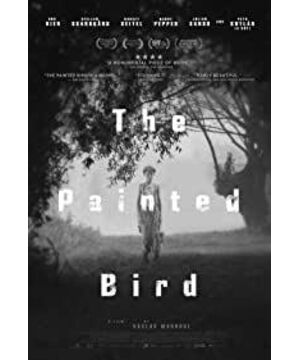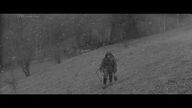Link to the original text: [ Shadow/"Smeared Bird": How heavy is the world, through the eyes of children ]
If the picture quality is not too clear, it is difficult to imagine that this film, which is almost a black and white silent film, is actually a "new film" (released in 2019).
In today's colorful world, black and white and silence are sometimes an "attitude", an independence that does not want to be in the company of the public; A more pure nostalgic nostalgia; sometimes an "aesthetic", a retro style that is already popular but doesn't want to be seen as popular.
However, black and white and silence, in this film, it can only be black and white and silence. It doesn't have any superfluous additional reason.
Because it is too heavy.
Words are not everything. The writing at the moment is also afraid of being too frivolous.
However, the film is based on the novel. This novel of the same name, first published in 1965, was banned for a time because it was too large. The author is Jerzy Kosinski (1933-1991) of Polish Jewish descent. As a survivor of World War II, he really experienced and witnessed many plots in the novel with his own eyes. The Czech director who was born after World War II, Vaclav Malhauer, re-presented the novel in the form of a film in the 28th year after the author's suicide, and almost stripped the text (in the film, almost stripped of dialogue), can also be seen as a tribute to the original author.
As for color. Ah, the color. Black and white are actually the richest colors. All the colors come together to make black. And all the light comes together to form white. If you experience it with your heart, you will even feel that in this film, black and white even shows a kind of "warmth". Just imagine what kind of ravages those naked, bloody shots would have been if they weren't black and white.
////
Not only is the film heavy, it's also puzzling.
The title (title of the novel) is a puzzle in itself. Does the painted bird, the painted bird, have any meaning? Looking at the official website of the film, there is a passage that describes it like this:
Kosiński borrowed the title “The Painted Bird” from the rural environment. This expression refers to a custom once popular in the countryside – people used to catch birds and painted their feathers in striking colours. After this, they released the painted bird back into its original environment. However, the other birds would never accept the painted bird back. It would be perceived as an enemy, a foreign element in the flock, and was pecked to death. The main character in the novel feels like a painted bird, as he encounters fear, scorn and cruelty all the time and everywhere simply because he is different. The main character of the novel is a young boy, who himself is THE PAINTED BIRD.
To the effect , there is a popular custom in the countryside where people paint the feathers of birds they catch and put them back where they belong. But by this time, the other birds no longer accepted the painted bird, so they pecked it to death. The boy in the novel is the painted bird.
In the film, there is an explanation about the "smeared bird". One was a bird man who painted a bird his lover had given him and released it into the sky in front of the little boy. Before long, the bird fell, and the little boy picked it up, stroked its wings, and wept.
In fact, before that, there was another scene about the fate metaphor of the "painted bird". That is, the footage of the movie poster propaganda, the little boy was buried in the soil, only his head was exposed, and a flock of birds pecked his head.
Thinking of this scene, you can understand why the little boy sobbed. He once had the experience of being pecked by a flock of birds, so when he saw a bird that was pecked to death by a flock of birds, he would feel that it was his companion.
Did he try his best to live because he wanted to break free from the shackles of such a fate? Although he is a painted bird, he does not want to have the fate of being pecked to death.
Had the boy been older, such a conjecture might have been true. But for a child who is still in his childhood, this speculation seems far-fetched and cruel. He should be enjoying a carefree life innocently!
So what is the driving force behind his tenacious life? At the beginning of the film, there is an explanation, that is, to reunite with parents. The little boy drew a picture, the picture is of his parents holding his hand, he wrote on it, "come to me", as if making a big wish, and then solemnly put it on the drift boat , along the river.
Therefore, at the end of the film, he was arranged to meet his father, which echoed from beginning to end. Some comments on the Internet believe that this ending is a failure. I don't agree with that. Although the little boy at this time, the idea of "going home" is not as simple as in the past, but it is still a seed, buried deep in his heart.
The last scene of the film is extremely moving. The little boy sitting next to his father looked at this strange and kind man with mixed feelings, until he saw the number on his arm, as if all of a sudden, all dissatisfaction, grief, doubt and other emotions disappeared. Then he wrote his name on the car window. At this time, the grand, empty and soulful ending music sounded, making people unable to stop crying.
It turned out that his father was also a smeared bird!
////
There are also puzzling points in the film's narrative.
The director divides the story into several acts, each of which is titled with a person's name except the opening. These people are important passers-by in the little boy's life. Through his eyes, the audience will see all kinds of absurd people and things, including blood, violence and pornography.
It was thought that the story of each scene might illustrate a theme, and eventually it would form a religious will like the Ten Commandments or the Seven Deadly Sins. For example, when the villagers thought the little boy had burned his grandmother to death, and beat him, did it represent suspicion? Does the male employer gouge out the eyes of the employee who has an affair with his wife, does it represent jealousy? But looking at it, I feel as if I can't summarize each story with a certain concept. The film certainly has a religious element, but it's not the core. Moreover, from the development of the story, the author should be skeptical of religion. An ironic contrast is that the priest took in the little boy with great compassion, only to send him into the hands of the devil without knowing it.
Since then, the little boy has started the Jedi counterattack and revenge, and his character has become "distorted". First he killed the demon who had bullied him, then he killed the ram who made him ashamed, then killed passers-by in the jungle and took his luggage.
Afterwards, the Soviet soldiers told him to "an eye for an eye, a tooth for a tooth" and gave him a gun when they parted. He later used that gun to kill the small trader who bullied him.
There is a scene in the film where a group of children wanted to provoke the little boy, but after seeing the gun in his waist, they all stepped aside and watched him leave.
The smeared bird is finally no longer weak and slaughtered, but has strength and weapons.
However, is this kind of "successful" armament really a victory?
Thinking back to those who did evil in the past, who has no "weapons"?
////
A child's childhood history is a history of war, society, and human nature. For this child, or for human society, I don't know whether it is a kind of luck or a kind of sadness.
This movie is made more and more heavy by the various experiences of this little boy. At the same time, there is also a trace of tenderness due to his continuous appearance.
In many cases, movies with children as the protagonists are not made for children. Like many cartoons, they are not made for children. For most children, it is impossible for them to understand the language in these shots. And adults, after experiencing the baptism of years, often look back at their past, and often have a different kind of emotion.
There may be a psychological explanation, that is, the reason why adults are enthusiastic about children's films that tell adults' stories is because they want to embrace who they were in this way, or embrace the child within themselves at the moment.
However, in this film, what kind of self are we going to embrace? We have not experienced war today, and we have experienced little or no absurdity in the film. So what are we embracing?
This probably points to the concept of "empathy". The reason why people can be moved by the joys and sorrows of others is because of the ability to empathize.
Because of empathy, we can sigh at every "painted bird".
In fact, each of us may also be the "painted bird".
[Welcome to pay attention to the personal public number: Informal Literature and Art Miscellaneous]
View more about The Painted Bird reviews











